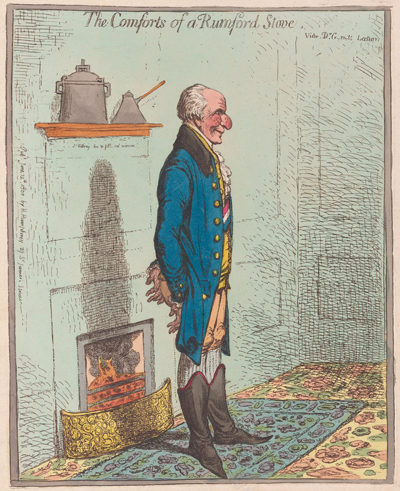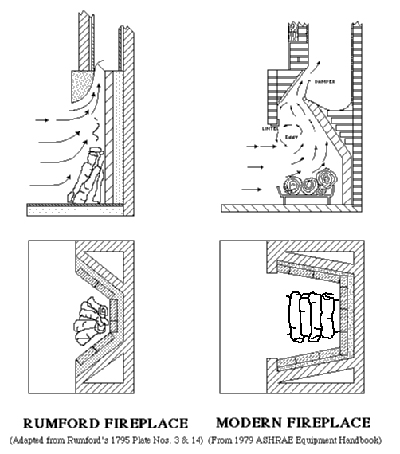The Comforts of a Rumford Stove
This is a portrait caricature of Benjamin Thompson (1753-1814), aka Count Rumford—scientist, inventor, reformer, and most recently one of the founders of "a Public Institution for diffusing the knowledge of Mechanical Inventions, and for teaching, by Philosophical Lectures and Experiments, the application of Science to the common purposes of Life."

© Beinecke Rare Book and Manuscript Library, Yale University
Rumford had described his idea in a detailed proposal written and published in early 1799. And thanks largely to his enthusiasm and meticulous managerial efforts, the Royal Institution, as it became known as, quickly gained subscribers and supporters from the British gentry and nobility, as well as a Royal patent from the King. By the Spring of 1800, buildings had been purchased, staff hired, and labs and temporary lecture hall constructed.
Approximately a year after the initial proposal, the first lectures were delivered March 4, 1800 taught by Thomas Garnett, who had been hired away from a similar position at Anderson's Institution in Glasgow. The day before the lectures began, there were approximately 500 members of the new Institution. Two months later, according to the June edition of the Monthly Magazine there were 1021, and a new and much larger lecture hall was being constructed, under Rumford's supervision, to accomodate 1,000 attendees. The last lecture for the first season had just concluded on June 10, two days before Gillray's print appeared. So the count could be forgiven for looking self-satisfied in Gillray's portrayal. The venture had been a resounding success.
The title of the print is something of a misnomer. The American-born Thompson, did indeed invent a fuel-efficient cast-iron stove that competed successfully against the Franklin stove, and an oven built into the wall next to the hearth, popularly known as Rumford's Roaster. But here he is standing before his most popular and influential invention—the Rumford Fireplace which he had first written about in a scientific paper in 1796 and is still considered one of the most effective and fuel-efficient fireplace designs. It features angled sides that helped direct heat into the room and a narrow throat with a rounded breast that increases updraft virtually eliminating the transmission of smoke into the rooom.

© Jim Buckley, Buckley Rumford Fireplaces
Like many Gillray designs, however, there is some ambiguity about the print's intent. The portrayal of the Count with his bulbous nose is hardly flattering. He seems to be wearing a French tri-color band across his chest and Hessian boots. These may be fashion statements or they may allude to his complicated multi-national identity. (He was born in American but served as a spy for the British during the American Revolution. He was an honorary member of the Académie des sciences, later married a French woman, and lived the last years of his life in France. He spent 11 years of his working life in Bavaria and was made a Count of the Holy Roman Empire (1792) for his efforts in reorganizing the army, encouraging better farming and crops, and creating schools and jobs for the poor.) The dark area above the mouth of the fireplace may be a shadow cast by his figure. Or it could be a cloud of smoke which would satirize his claims of inventing a smokeless fireplace. And finally there is the ambiguous instruction just beneath the main title: "Vide. Dr G-rn-ts lectures.
Not surprisingly, Garnett's lectures, as described in the July issue of the Monthly Magazine, include references to Rumford's work.
"The subject of heat was concluded by an account of Count Rumford's interesting discoveries with respect to the conducting powers of different bodies with respect to heat. . . . The mechanical properties of air were next examined, which constitute the branch commonly called pneumatics; with acoustics, or the theory of sound. Count Rumford's improvements with respect to the economy of fuel, and the prevention of chimneys from smoking, were then particularly explained, and illustrated by models of his roasters, &c.
Gillray's note may simply be pointing at Garnett's lectures for further explanation of the Rumford Fireplace and other Rumford appliances. But it may also, according to the British Museum commentary, allude to the tension between Garnett and Rumford over Rumford's tendency to micromanage everything about the Institution, including Garnett. The best account of the interactions which eventually led to Garnett's resignation as principal lecturer and replacement by Sir Humphrey Davy can be found in Thomas Martin's article, "Early Years at the Royal Institution" in the British Journal of the History of Science..
Whether satiric or not, if we can believe the 1830 McLean commentary on this print (quoted by Draper Hill), Gillray's treatment of him did not stop Rumford from buying extra copies of The Comfort of a Rumford Stove to distribute to his friends with the following inscription:
This is so much more like the Count—than he is himself, that when you look upon it, you cannot fail to think of your humble servant—the donor.
Sources and Reading
- Commentary from the British Museum on The Comforts of a Rumford Stove.
- Draper Hill, The Satirical Etchings of James Gillray, 1976, #75.
- "Benjamin Thompson," Wikipedia
- "Count Rumford. . .," Dartmouth College Library Bulletin
- "Rumford fireplace," Wikipedia
- "Thomas Garnett (physician)," Wikipedia
- "Royal Institution," Wikipedia
- Thomas Martin, "Early Years at the Royal Institution," British Journal of the History of Science, Vol. 2, No. 2, pp. 99-115.
- Thomas Wright and R.H. Evans, Historical and Descriptive Account of the Caricatures of James Gillray #459.
- Thomas Wright and Joseph Grego, The Works of James Gillray, the Caricaturist; With the History of His Life and Times, p. 271.
Comments & Corrections
NOTE: Comments and/or corrections are always appreciated. To make that easier, I have included a form below that you can use. I promise never to share any of the info provided without your express permission.